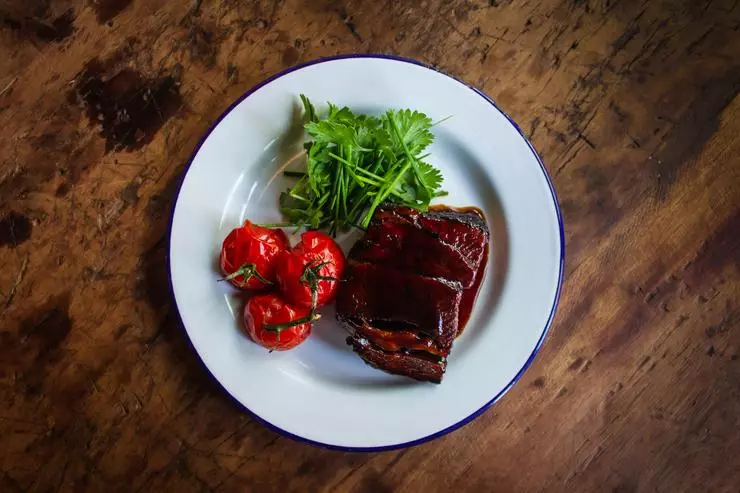The glycemic index is an indicator that is used to control blood sugar levels. The glycemic food index is influenced by several factors, including its composition, a method of preparation, product maturity. It can not only help you realize that you put on a plate, but also increase weight loss, reduce blood sugar levels and reduce cholesterol levels. We give the translation of the English-language material of the HealthLine edition, in which it is clearly explained, why do you need to know the glycemic index of products.
What is a glycemic index
The glycemic index (GI) is the value used to measure how defined products increase blood sugar levels. Products are classified as low, medium or high glycemic index products and are ranked on a scale from 0 to 100. The lower the gi-specific product, the less it can affect blood sugar levels according to the study "Glycemic Index and Glycemic Load: Measurement Issues and Their Effect ON Diet-Disease Relationships.

High Gi products slow down slimming
Photo: unsplash.com.
Here are three GI rating:
Low: 55 or less
Average: 56-69
High: 70 or higher
Products with high refined carbohydrates and sugars are digested faster and often have high gi, while high protein, fats or fiber products usually have low gi. Products that do not contain carbohydrates do not have GI and include meat, fish, bird, nuts, seeds, herbs, spices and oils. Other factors that affect the gi products include maturity, the cooking method, the type of sugar, which it contains.
Keep in mind that the glycemic index differs from the glycemic load (GL). Unlike Gi, which does not take into account the amount of food eaten, GL determines the amount of carbohydrates in portions of the product to determine how this may affect blood sugar levels. For this reason, it is important to take into account both the glycemic index and a glycemic load when choosing products to maintain a healthy blood sugar level.
Low Glycemic Index Diet
A low-glycemic index diet includes a replacement of high gi products on those who have low gi. Compliance with a low glycemic index diet can benefit health, including:
Improving the regulation of blood sugar levels. Many studies, for example, "Decrease in Glycemic Index Associated with Improved Glyce" showed that the compliance with low gi diet can reduce blood sugar levels and improving blood sugar levels in people with type 2 diabetes.
Fast weight loss. Some studies show that the observance of low gi diet can lead to short-term weight loss. Additional research is needed to determine how this affects long-term weight management.
Reduced cholesterol levels. Compliance with low gi diet can help reduce levels both in common and LDL (poor) cholesterol, which are the risk factors of cardiovascular diseases.

Do not remove carbohydrates at all - all products are useful.
Photo: unsplash.com.
How to follow diet
A healthy low-glycemic index diet should include mainly low gi products, such as:
Fruits: Apples, Berries, Oranges, Lemons, Limes, Grapefruit
Rich in fiber vegetables: broccoli, cauliflower, carrots, spinach, tomatoes
Whole grain: Swan, Couscous, barley, buckwheat, Farro, Oats
Legumes: lentils, black beans, nuts, beans
Food without a Gi value or with very low Gi can also be used as part of a balanced diet with a low glycemic index. They include:
Meat: beef, bison, lamb, pork
Seafood: Tuna, Salmon, Shrimps, Mackerel, Anchovies, Sardines
Poultry: chicken, turkey, duck, goose
Oils: Olive oil, Coconut oil, Avocado oil, Vegetable oil
Nuts: almonds, macadamia, walnuts, pistachios
Seeds: Seeds Chia, sesame seeds, cannabis seeds, flax seeds
Herbs and spices: turmeric, black pepper, cumin, dill, basil, rosemary, cinnamon
Although no products are strictly prohibited for eating food, products with high gi should be limited.
Products with high gi include:
Bread: White bread, bagels, Naan, Lavash
Fig: white rice, jasmine rice, rice arborio
Grain: Fast Capture Oats, Dry Breakfast
Pasta and noodles: Lazagany, Spaghetti, Ravioli, Pasta, Fettuccini
Starchy vegetables: mashed potatoes, potatoes, french fries
Baking: cake, donuts, cookies, croissants, muffins
Snacks: chocolate, crackers, microwave, popcorn, chips, pretzels
Sugar-containing drinks: soda, fruit juices, sports drinks
Ideally, try to replace these products on products with lower gi.
Following a low-glycemic index diet implies the exchange of products with high gi with alternatives with low gi. A low-glycemic index diet can help control blood sugar levels, reduce cholesterol levels and speed up the short-term weight loss.
